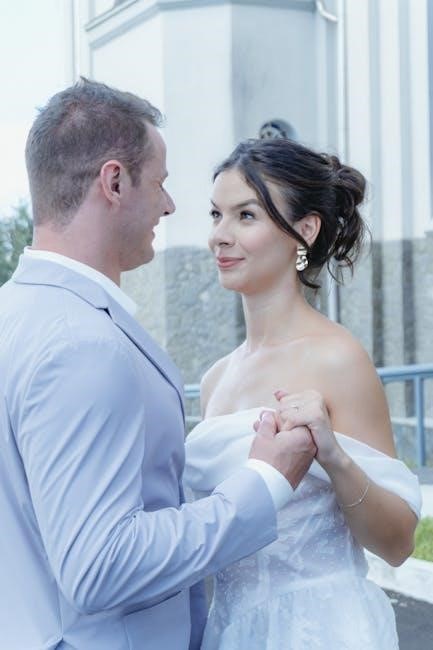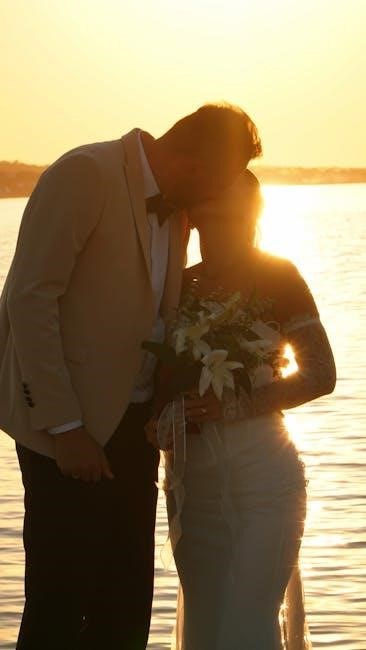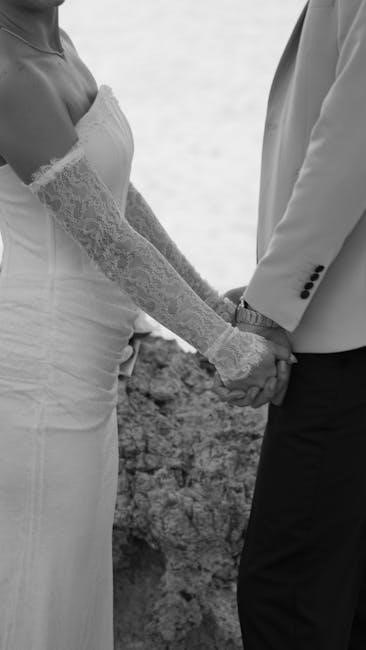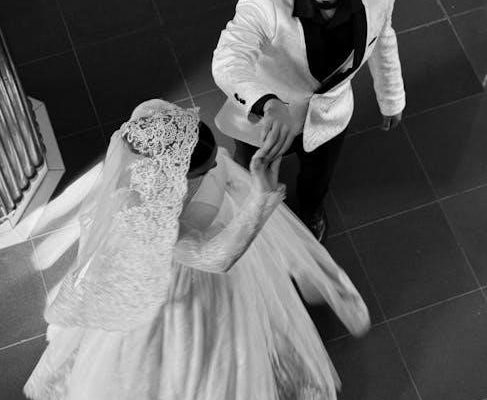Felix Mendelssohn’s Wedding March is a renowned piece from his suite for A Midsummer Night’s Dream. It has become a traditional wedding processional‚ symbolizing joy and celebration‚ with sheet music widely available for download in PDF format.

Origin and Significance
Felix Mendelssohn’s Wedding March originated as part of his incidental music for Shakespeare’s A Midsummer Night’s Dream (Op. 61)‚ composed in 1843. Initially‚ it was not written specifically for weddings but as a processional piece for the play. However‚ its grand and triumphant melody made it a perfect fit for wedding ceremonies. The march gained popularity after Queen Victoria used it in her wedding to Prince Frederick of Prussia‚ solidifying its association with weddings. Today‚ it is one of the most recognizable and frequently used wedding pieces worldwide‚ often played on church organs. Its significance lies in its ability to evoke joy and celebration‚ making it a timeless choice for couples. Sheet music for the Wedding March is widely available in PDF format‚ allowing musicians to perform it in various arrangements.
Historical Background
Felix Mendelssohn’s Wedding March was composed in 1843 as part of his incidental music for Shakespeare’s A Midsummer Night’s Dream (Op. 61). It was not initially intended for weddings but became a wedding staple after Queen Victoria’s marriage in 1858. The march’s grandeur and triumphant melody made it a perfect fit for ceremonial use‚ leading to its widespread adoption globally. Its historical significance is tied to its role in popularizing wedding music traditions‚ with sheet music now widely available in PDF format for various instruments‚ ensuring its enduring legacy.
Composition for A Midsummer Night’s Dream
Felix Mendelssohn’s Wedding March was originally composed in 1843 as part of his incidental music for William Shakespeare’s play A Midsummer Night’s Dream (Op. 61). The piece was written at the request of King Frederick William IV of Prussia‚ who wanted music to accompany a production of the play. Mendelssohn created a suite of 13 pieces‚ with the Wedding March being the fourth movement. The music was intended to evoke the joy and magic of the play’s conclusion‚ where characters celebrate their unions. Interestingly‚ the march was not initially associated with weddings but became a popular choice for wedding processions after Queen Victoria’s marriage in 1858. Its grand‚ triumphant melody and orchestration‚ featuring a regal brass fanfare followed by a lyrical theme‚ have made it a timeless classic. Today‚ the sheet music for this piece is widely available in PDF format‚ allowing musicians to perform and enjoy it in various arrangements.
Adoption in Wedding Ceremonies
Felix Mendelssohn’s Wedding March gained widespread popularity as a wedding processional after Queen Victoria’s marriage to Prince Albert in 1858. The queen’s choice to use the piece during her ceremony elevated its status‚ making it a staple in wedding traditions. Its triumphant and joyful melody‚ originally composed for A Midsummer Night’s Dream‚ resonated with the celebration of marriage. Over time‚ the march became synonymous with weddings worldwide‚ symbolizing happiness and unity. Today‚ it is often played during the bride’s entry or recessional‚ setting a grand and festive tone. The availability of Mendelssohn’s Wedding March in PDF format has further facilitated its use‚ allowing musicians and couples to easily access and perform the piece. This adoption has cemented its role as one of the most recognizable and enduring wedding traditions in history.

Structure and Composition
Mendelssohn’s Wedding March features a grand orchestral arrangement‚ blending dynamic brass‚ delicate woodwinds‚ and rich strings. Its composition reflects the Romantic era’s dramatic and expressive musical style‚ creating a celebratory atmosphere.
Musical Structure
Mendelssohn’s Wedding March is structured in a grand‚ triumphant form‚ reflecting its celebratory purpose. The piece begins with a dramatic orchestral introduction‚ setting a joyous tone. It transitions into a lively‚ rhythmic main theme‚ characterized by ascending arpeggios and a soaring melody. The march is written in a major key‚ enhancing its festive and optimistic atmosphere. The composition features a clear binary form‚ with a strong contrast between the exuberant outer sections and a lyrical‚ elegant middle section. Dynamics play a crucial role‚ building from a soft introduction to a glorious climax. The piece concludes with a triumphant reprise of the main theme‚ leaving a lasting impression. This structured approach ensures the march remains both cohesive and emotionally resonant‚ perfectly capturing the essence of a wedding celebration.
Key and Melody
Mendelssohn’s Wedding March is composed in the key of C major‚ which contributes to its grandeur and celebratory tone. The melody is both triumphant and lyrical‚ with a strong rhythmic pulse that evokes joy and procession. The main theme features a bright‚ ascending motif‚ while the secondary theme introduces a more elegant‚ flowing melody. The interplay between these themes creates a sense of balance and harmony. The use of orchestral brass and strings enhances the melody’s brilliance‚ making it a perfect accompaniment for ceremonial processionals. The key of C major also allows for a wide range of tonal colors‚ from soft‚ delicate passages to powerful climaxes. This combination of melody and key ensures the march remains timeless and emotionally resonant‚ fitting seamlessly into wedding celebrations worldwide.
Instrumentation
Mendelssohn’s Wedding March is originally scored for a full orchestra‚ including strings‚ woodwinds‚ brass‚ and percussion. The piece features a grand orchestration‚ with the strings often carrying the main melody‚ while the woodwinds provide harmonic support. The brass section‚ particularly trumpets and trombones‚ adds a triumphant and celebratory tone‚ especially in the climax. The percussion‚ including timpani and cymbals‚ underscores the rhythmic energy. The orchestration creates a balance of power and elegance‚ making it ideal for ceremonial use. Smaller arrangements‚ such as those for organ or piano‚ are also popular‚ preserving the march’s emotional impact in more intimate settings. The versatility of the instrumentation allows it to be adapted for various ensembles‚ ensuring its widespread use in weddings and performances. The full orchestral version remains the most iconic‚ embodying the joy and grandeur of the occasion.
Influence of the Romantic Era
Felix Mendelssohn’s Wedding March reflects the artistic and emotional ideals of the Romantic Era‚ a period characterized by heightened expressiveness and dramatic contrasts. Composed in 1842‚ the piece embodies the Romantic spirit through its sweeping melodies‚ rich harmonies‚ and grand orchestration. Mendelssohn’s use of lyrical themes and dynamic shifts captures the emotional depth and intensity typical of Romantic music. The march’s triumphant and joyous tone aligns with the era’s emphasis on celebrating life’s grand moments; Additionally‚ Mendelssohn’s ability to blend classical forms with Romantic expressiveness showcases his unique style within the period. The Wedding March not only highlights Mendelssohn’s mastery but also exemplifies how Romantic music could evoke powerful emotions‚ making it a timeless choice for ceremonial celebrations. Its enduring popularity underscores the lasting impact of Romantic ideals on musical expression.

Cultural Significance
Mendelssohn’s Wedding March holds profound cultural significance‚ symbolizing joy and unity globally. Its universal appeal has made it a staple in wedding traditions and popular culture‚ transcending time and trends.

Role in Wedding Ceremonies
Mendelssohn’s Wedding March is arguably the most recognizable piece of music associated with weddings worldwide. Traditionally played during the recessional‚ it marks the joyful exit of the newlyweds‚ evoking feelings of celebration and unity. Its triumphant melody and harmonious structure create an atmosphere of elation‚ making it a timeless choice for couples. The piece has been used in countless ceremonies‚ including royal weddings‚ further cementing its association with marital bliss. Its widespread adoption reflects its ability to transcend cultural boundaries‚ becoming a universal symbol of love and commitment. Despite the rise of modern wedding music‚ Mendelssohn’s Wedding March remains a beloved tradition‚ cherished for its emotional resonance and historical significance. Its enduring popularity underscores its role as a cornerstone of wedding celebrations globally.
Association with Queen Victoria
Mendelssohn’s Wedding March gained significant prominence after its association with Queen Victoria. In 1858‚ the march was played during the wedding of Victoria‚ Princess Royal‚ the eldest daughter of Queen Victoria‚ to Prince Frederick William of Prussia. This royal endorsement catapulted the piece into widespread popularity‚ linking it forever with wedding traditions. Although Queen Victoria herself did not use the march during her own wedding‚ her family’s adoption of it solidified its connection to British royal weddings. The march’s grandeur and joyful tone resonated with the pomp and circumstance of royal ceremonies‚ making it a natural choice for such occasions. This association has endured‚ with the piece remaining a beloved tradition in weddings across the globe‚ often evoking memories of royal celebrations and timeless romance.
Global Recognition
Mendelssohn’s Wedding March has attained unparalleled global recognition‚ transcending cultural and geographical boundaries. Its triumphant melody and celebratory tone have made it a staple in wedding ceremonies worldwide. The piece is widely regarded as the quintessential wedding processional‚ symbolizing joy‚ unity‚ and new beginnings. Its popularity extends across continents‚ with couples from diverse backgrounds incorporating it into their weddings. The march’s universal appeal lies in its ability to evoke emotions that resonate with people of all cultures. Its widespread use in films‚ advertisements‚ and media has further cemented its status as an iconic representation of marriage celebrations. As a result‚ Mendelssohn’s Wedding March remains one of the most recognizable and beloved compositions in the world‚ continuing to inspire new generations of couples and musicians alike.
Wedding Traditions and Music
Music plays a central role in wedding traditions‚ setting the tone for celebrations and creating lasting memories. Mendelssohn’s Wedding March is a timeless choice‚ symbolizing joy and unity‚ while modern couples often blend traditional and contemporary pieces to reflect their personal style. The right melody can elevate the ceremony‚ procession‚ and reception‚ making each moment unforgettable. Cultural influences also shape wedding music‚ with many incorporating local instruments or songs to honor heritage. Ultimately‚ music is a universal language that unites families and friends‚ celebrating love’s enduring spirit. Its significance in weddings continues to evolve‚ adapting to societal changes while preserving cherished customs. The careful selection of music ensures a meaningful and memorable experience for all involved. The harmonious blend of tradition and innovation keeps wedding music vibrant and heartfelt. Music remains an indispensable element‚ enriching every aspect of the celebration. Couples often choose melodies that resonate with their personal journey‚ making their wedding uniquely their own. Love stories are beautifully told through the melodies that accompany each cherished moment. Wedding music transcends words‚ speaking directly to the heart and creating an atmosphere of joy and anticipation. It is through music that emotions are shared and memories are forged‚ making it an integral part of wedding traditions worldwide. The enduring beauty of wedding music lies in its ability to connect people across generations and cultures‚ celebrating the universal theme of love. Music’s power to inspire and unite is at the heart of every wedding celebration‚ ensuring its lasting significance in wedding traditions. The careful selection of music ensures a meaningful and memorable experience for all involved. The harmonious blend of tradition and innovation keeps wedding music vibrant and heartfelt. Music remains an indispensable element‚ enriching every aspect of the celebration. Couples often choose melodies that resonate with their personal journey‚ making their wedding uniquely their own. Love stories are beautifully told through the melodies that accompany each cherished moment. Wedding music transcends words‚ speaking directly to the heart and creating an atmosphere of joy and anticipation. It is through music that emotions are shared and memories are forged‚ making it an integral part of wedding traditions worldwide. The enduring beauty of wedding music lies in its ability to connect people across generations and cultures‚ celebrating the universal theme of love. Music’s power to inspire and unite is at the heart of every wedding celebration‚ ensuring its lasting significance in wedding traditions.
Role of Music in Weddings
Music is a cornerstone of wedding celebrations‚ evoking emotions and creating timeless memories. It sets the tone for the ceremony‚ procession‚ and reception‚ guiding the atmosphere from solemnity to joy. Mendelssohn’s Wedding March‚ a beloved choice‚ symbolizes happiness and unity‚ while modern couples often blend genres to reflect their personal style. Music serves as a universal language‚ connecting guests and celebrating love. Its presence enhances key moments‚ such as the bride’s entrance or first dance‚ making these experiences unforgettable. Whether classical or contemporary‚ music tailors the wedding to the couple’s identity‚ ensuring a meaningful and heartfelt celebration.
Significance of the Wedding March
The Wedding March‚ particularly Mendelssohn’s composition‚ holds profound cultural and emotional significance in wedding ceremonies worldwide. Its triumphant and joyful melody symbolizes celebration‚ unity‚ and the transition to married life. Often played during the bride’s procession‚ it creates an atmosphere of anticipation and happiness. The piece has become a timeless tradition‚ transcending generations and cultural boundaries. Its association with weddings is so strong that it is almost universally recognized as a symbol of matrimony. Mendelssohn’s Wedding March was popularized by Queen Victoria’s wedding‚ further cementing its place in wedding customs. Today‚ it remains a standard choice‚ often adapted to suit various wedding styles‚ ensuring its enduring appeal and relevance in modern ceremonies.

Downloading the Sheet Music
Mendelssohn’s Wedding March sheet music is widely available online in various formats‚ including PDF‚ making it easily accessible for download and use in wedding ceremonies and performances.
Sources for PDF Download
Mendelssohn’s Wedding March sheet music in PDF format can be downloaded from various online platforms‚ including music libraries‚ sheet music repositories‚ and classical music websites. The International Music Score Library Project (IMSLP) is a popular source‚ offering free access to public domain works. Additionally‚ websites like Musicnotes‚ Sheet Music Plus‚ and 8notes provide downloadable PDFs‚ often with multiple arrangements for different instruments. Some platforms may require a subscription or a one-time purchase‚ while others offer free versions‚ depending on the arrangement complexity. When downloading‚ ensure the source is reputable and verify the sheet music’s accuracy; This ensures the music aligns with the original composition’s intent and quality‚ making it suitable for weddings‚ performances‚ or personal use;
Arrangements and Instrumentations
Mendelssohn’s Wedding March is available in various arrangements and instrumentations‚ catering to diverse performance needs. The original composition is for orchestra‚ featuring a grand arrangement with strings‚ woodwinds‚ brass‚ and percussion. However‚ it has been transcribed for solo piano‚ organ‚ and smaller ensembles‚ making it accessible for intimate settings. Many arrangements emphasize the piece’s triumphant melody‚ often highlighting the interplay between violins and trumpets. For weddings‚ piano or organ versions are popular due to their simplicity and emotional impact. Additionally‚ instrumental arrangements for quartets‚ trios‚ or solo instruments like violin or guitar are widely available. These adaptations ensure the march can be performed in different contexts‚ from large ceremonies to private gatherings. The versatility of Mendelssohn’s composition has made it a timeless choice for celebrating nuptials worldwide.

Considerations for Downloading
When downloading Mendelssohn’s Wedding March as a PDF‚ several factors should be considered to ensure a seamless and satisfying experience. First‚ verify the source’s credibility to avoid copyrighted material or low-quality downloads. Many reputable websites offer free or paid versions‚ so choosing one that aligns with your needs is essential. Check the arrangement’s compatibility with your instrumentation‚ as some versions are tailored for specific ensembles or solo performances. Additionally‚ ensure the PDF is in high resolution for clear readability. If the sheet music is for a performance‚ consider the skill level of the musicians and select an arrangement that matches their abilities. Lastly‚ review the version’s fidelity to the original composition to preserve its timeless elegance and emotional impact. Taking these steps ensures the Wedding March enhances your celebration with its classic beauty and grandeur.

Performance and Arrangements
Mendelssohn’s Wedding March is often performed in orchestral and solo arrangements‚ showcasing its timeless appeal. The composition’s grandeur and melody make it a popular choice for both traditional and modern ceremonies‚ ensuring its enduring relevance in wedding celebrations worldwide.
Orchestral and Solo Performances
Mendelssohn’s Wedding March is widely performed in both orchestral and solo arrangements‚ showcasing its versatility. The orchestral version‚ with its grand brass fanfares and sweeping strings‚ evokes joy and elegance‚ making it a wedding staple. Solo performances‚ often on piano or organ‚ highlight the melody’s lyrical beauty and emotional depth. The march’s structure allows for adaptation across various instruments‚ ensuring its universal appeal. Many musicians and ensembles worldwide perform these arrangements‚ demonstrating the piece’s enduring popularity; Its ability to resonate in both grand and intimate settings solidifies its place in wedding traditions and classical music repertoire.
Modern Arrangements
Mendelssohn’s Wedding March has inspired countless modern arrangements‚ blending tradition with contemporary styles. Artists and composers often reinterpret the piece‚ incorporating elements like rock‚ jazz‚ or electronic music to create fresh renditions. These arrangements maintain the march’s iconic melody while offering innovative twists‚ appealing to diverse audiences. For instance‚ some versions feature synthesizers or electric guitars‚ while others emphasize orchestral crescendos for dramatic effect. Digital platforms offer downloadable sheet music‚ allowing musicians to explore these modern interpretations easily. Such arrangements not only honor Mendelssohn’s legacy but also ensure the march remains relevant in today’s musical landscape. These creative reimaginations highlight the timeless appeal of the Wedding March‚ making it a versatile choice for modern weddings and performances.
Use in Pop Culture
Mendelssohn’s Wedding March has become a staple in pop culture‚ frequently appearing in films‚ television shows‚ and commercials. Its recognizable melody evokes a sense of celebration and joy‚ making it a popular choice for scenes depicting weddings or romantic moments. For example‚ it has been featured in classic Disney movies and romantic comedies‚ further cementing its association with love and marriage. Additionally‚ the march has been parodied and reimagined in humorous contexts‚ showcasing its versatility. Its widespread use in media has introduced the piece to new generations‚ ensuring its enduring relevance. The Wedding March’s universal appeal continues to make it a favorite in both traditional and modern cultural contexts‚ highlighting its timeless charm and emotional resonance.
Mendelssohn’s Wedding March remains a timeless symbol of joy and celebration‚ deeply rooted in cultural and romantic traditions. Its enduring legacy continues to inspire and unite people worldwide.
Mendelssohn’s Wedding March is celebrated for its cultural significance and timeless appeal. As one of the most recognizable pieces in wedding ceremonies‚ it embodies joy‚ unity‚ and celebration. Its association with Queen Victoria popularized its use in weddings‚ solidifying its place in tradition. The march’s uplifting melody and grand orchestration create an atmosphere of solemnity and happiness‚ making it a cornerstone of wedding music. Its availability in PDF format ensures accessibility for musicians and couples worldwide‚ allowing it to be adapted to various instrumental arrangements. The piece transcends generations‚ resonating emotionally with people across cultures. Its enduring popularity reflects its ability to evoke universal feelings of love and commitment‚ making it an indispensable part of wedding celebrations globally. Mendelssohn’s Wedding March continues to inspire and unite‚ ensuring its lasting legacy in music and wedding traditions;

Lasting Impact on Weddings

Mendelssohn’s Wedding March has left an indelible mark on wedding traditions worldwide. Its triumphant melody and joyful rhythm have become synonymous with celebrating love and commitment. Since its adoption in the 19th century‚ the piece has transcended cultural boundaries‚ becoming a universal symbol of matrimony. Its widespread use in ceremonies‚ from grand orchestral performances to intimate piano arrangements‚ underscores its versatility and enduring charm. The march’s ability to evoke emotions of happiness and unity ensures its continued relevance in modern weddings. Even with evolving musical trends‚ Mendelssohn’s composition remains a timeless choice‚ bridging generations and preserving its role as a cherished wedding tradition. Its legacy endures‚ making it an integral part of celebrating one of life’s most significant moments.



